Recycling Glass and Carbon Fibers for Reusable Components in the Automotive Sector through Additive Manufacturing
Abstract
1. Introduction
2. Materials and Methods
2.1. Materials
2.2. Indirect FFF 3D Printing
2.3. UV-Assisted Direct Ink Writing (UV-DIW)
2.4. Tensile Tests
3. Results and Discussion
3.1. Case Study from the Automotive Sector
3.2. Tensile Tests
3.3. Indirect FFF 3D Printing
3.4. UV-Assisted Direct Ink Writing (UV-DIW)
3.5. Case Study Validation
4. Conclusions
- The first workflow (indirect FFF 3D printing) appears as the most suitable path to produce small batches of prototypes or parts with coarse recyclates, especially rCFRPs. The use of more conventional AM processes results in higher accuracy and less post-processing, despite lower shape complexity due to the mold.
- The second workflow (UV-DIW) helps in developing the first prototypes made with rGFRPs. It may also be used to customize the shape and materials of the final components, as well as its mechanical and technical properties, by designing new meta-materials. However, fine recyclate powders should be used to better control reprocessing, i.e., avoiding clogging.
Author Contributions
Funding
Institutional Review Board Statement
Informed Consent Statement
Data Availability Statement
Acknowledgments
Conflicts of Interest
References
- Global Composites Market Size, Share & Growth Report, 2030. Available online: https://www.grandviewresearch.com/industry-analysis/composites-market (accessed on 8 March 2023).
- Qureshi, J. A Review of Recycling Methods for Fibre Reinforced Polymer Composites. Sustainability 2022, 14, 16855. [Google Scholar] [CrossRef]
- Khalid, M.Y.; Arif, Z.U. Novel Biopolymer-Based Sustainable Composites for Food Packaging Applications: A Narrative Review. Food Packag. Shelf Life 2022, 33, 100892. [Google Scholar] [CrossRef]
- Arif, Z.U.; Khalid, M.Y.; Sheikh, M.F.; Zolfagharian, A.; Bodaghi, M. Biopolymeric Sustainable Materials and Their Emerging Applications. J. Environ. Chem. Eng. 2022, 10, 108159. [Google Scholar] [CrossRef]
- Romani, A.; Rognoli, V.; Levi, M. Design, Materials, and Extrusion-Based Additive Manufacturing in Circular Economy Contexts: From Waste to New Products. Sustainability 2021, 13, 7269. [Google Scholar] [CrossRef]
- Arif, Z.U.; Khalid, M.Y.; Ahmed, W.; Arshad, H.; Ullah, S. Recycling of the Glass/Carbon Fibre Reinforced Polymer Composites: A Step towards the Circular Economy. Polym. Plast. Technol. Mater. 2022, 61, 761–788. [Google Scholar] [CrossRef]
- Campbell-Johnston, K.; Vermeulen, W.J.V.; Reike, D.; Brullot, S. The Circular Economy and Cascading: Towards a Framework. Resour. Conserv. Recycl. 2020, 7, 100038. [Google Scholar] [CrossRef]
- Ceschin, F.; Gaziulusoy, I. Evolution of Design for Sustainability: From Product Design to Design for System Innovations and Transitions. Des. Stud. 2016, 47, 118–163. [Google Scholar] [CrossRef]
- Khalid, M.Y.; Arif, Z.U.; Hossain, M.; Umer, R. Recycling of Wind Turbine Blades through Modern Recycling Technologies: A Road to Zero Waste. Renew. Energy Focus 2023, 44, 373–389. [Google Scholar] [CrossRef]
- Corona, B.; Shen, L.; Reike, D.; Rosales Carreón, J.; Worrell, E. Towards Sustainable Development through the Circular Economy—A Review and Critical Assessment on Current Circularity Metrics. Resour. Conserv. Recycl. 2019, 151, 104498. [Google Scholar] [CrossRef]
- Khalid, M.Y.; Arif, Z.U.; Al Rashid, A. Investigation of Tensile and Flexural Behavior of Green Composites along with Their Impact Response at Different Energies. Int. J. Precis. Eng. Manuf. Green Technol. 2022, 9, 1399–1410. [Google Scholar] [CrossRef]
- Javaid, M.; Haleem, A.; Singh, R.P.; Suman, R.; Rab, S. Role of Additive Manufacturing Applications towards Environmental Sustainability. Adv. Ind. Eng. Polym. Res. 2021, 4, 312–322. [Google Scholar] [CrossRef]
- Sauerwein, M.; Doubrovski, E.; Balkenende, R.; Bakker, C. Exploring the Potential of Additive Manufacturing for Product Design in a Circular Economy. J. Clean. Prod. 2019, 226, 1138–1149. [Google Scholar] [CrossRef]
- Ford, S.; Despeisse, M. Additive Manufacturing and Sustainability: An Exploratory Study of the Advantages and Challenges. J. Clean. Prod. 2016, 137, 1573–1587. [Google Scholar] [CrossRef]
- Giani, N.; Mazzocchetti, L.; Benelli, T.; Picchioni, F.; Giorgini, L. Towards Sustainability in 3D Printing of Thermoplastic Composites: Evaluation of Recycled Carbon Fibers as Reinforcing Agent for FDM Filament Production and 3D Printing. Compos. Part A Appl. Sci. Manuf. 2022, 159, 107002. [Google Scholar] [CrossRef]
- Mantelli, A.; Romani, A.; Suriano, R.; Levi, M.; Turri, S. Direct Ink Writing of Recycled Composites with Complex Shapes: Process Parameters and Ink Optimization. Adv. Eng. Mater. 2021, 23, 2100116. [Google Scholar] [CrossRef]
- Savastano, M.; Amendola, C.; D′Ascenzo, F.; Massaroni, E. 3-D Printing in the Spare Parts Supply Chain: An Explorative Study in the Automotive Industry. In Digitally Supported Innovation; Caporarello, L., Cesaroni, F., Giesecke, R., Missikoff, M., Eds.; Springer International Publishing: Cham, Switzerland, 2016; pp. 153–170. [Google Scholar] [CrossRef]
- Dalpadulo, E.; Petruccioli, A.; Gherardini, F.; Leali, F. A Review of Automotive Spare-Part Reconstruction Based on Additive Manufacturing. J. Manuf. Mater. Process. 2022, 6, 133. [Google Scholar] [CrossRef]
- Romani, A.; Levi, M. Indirect 3D Printing of Recycled Glass Fibres from End-of-Life Products: Towards a Design Engineering Approach to Circular Design. In Proceedings of the 20th European Roundtable on Sustainable Consumption and Production, Graz, Austria, 8–10 September 2021; Schnitzer, H., Braunegg, S., Eds.; Verlag der Technischen Universität Graz: Graz, Austria, 2021; pp. 515–530. [Google Scholar] [CrossRef]
- Romani, A.; Mantelli, A.; Suriano, R.; Levi, M.; Turri, S. Additive Re-Manufacturing of Mechanically Recycled End-of-Life Glass Fiber-Reinforced Polymers for Value-Added Circular Design. Materials 2020, 13, 3545. [Google Scholar] [CrossRef]
- Mantelli, A.; Romani, A.; Suriano, R.; Levi, M.; Turri, S. Additive Manufacturing of Recycled Composites. In Systemic Circular Economy Solutions for Fiber Reinforced Composites; Colledani, M., Turri, S., Eds.; Digital Innovations in Architecture, Engineering and Construction; Springer International Publishing: Cham, Switzerland, 2022; pp. 141–166. ISBN 978-3-031-22352-5. [Google Scholar]
- Mantelli, A.; Romani, A.; Suriano, R.; Diani, M.; Colledani, M.; Sarlin, E.; Turri, S.; Levi, M. UV-Assisted 3D Printing of Polymer Composites from Thermally and Mechanically Recycled Carbon Fibers. Polymers 2021, 13, 726. [Google Scholar] [CrossRef]
- Dizon, J.R.C.; Valino, A.D.; Souza, L.R.; Espera, A.H.; Chen, Q.; Advincula, R.C. Three-Dimensional-Printed Molds and Materials for Injection Molding and Rapid Tooling Applications. MRS Commun. 2019, 9, 1267–1283. [Google Scholar] [CrossRef]
- Romero, P.E.; Arribas-Barrios, J.; Rodriguez-Alabanda, O.; González-Merino, R.; Guerrero-Vaca, G. Manufacture of Polyurethane Foam Parts for Automotive Industry Using FDM 3D Printed Molds. CIRP J. Manuf. Sci. Technol. 2021, 32, 396–404. [Google Scholar] [CrossRef]
- Post, B.K.; Chesser, P.C.; Lind, R.F.; Roschli, A.; Love, L.J.; Gaul, K.T.; Sallas, M.; Blue, F.; Wu, S. Using Big Area Additive Manufacturing to Directly Manufacture a Boat Hull Mould. Virtual Phys. Prototyp. 2018, 14, 123–129. [Google Scholar] [CrossRef]
- Rossing, L.; Scharff, R.B.N.; Chömpff, B.; Wang, C.C.L.; Doubrovski, E.L. Bonding between Silicones and Thermoplastics Using 3D Printed Mechanical Interlocking. Mater. Des. 2020, 186, 108254. [Google Scholar] [CrossRef]
- ASTM D3039; Standard Test Method for Tensile Properties of Polymer Matrix Composite Materials. ASTM International: West Conshohocken, PA, USA, 2017.
- Von Freeden, J.; Husemann, A.; Caba, S. Component Reuse Strategy (CRS) for Continuous Reinforced Thermo-Sets Enabling Circular Economy. J. Remanuf. 2022, 12, 339–355. [Google Scholar] [CrossRef]
- Caba, S.; von Freeden, J.; de Wit, J.; Huxdorf, O. Use Case 3: Modular Car Parts Disassembly and Remanufacturing. In Systemic Circular Economy Solutions for Fiber Reinforced Composites; Colledani, M., Turri, S., Eds.; Digital Innovations in Architecture, Engineering and Construction; Springer International Publishing: Cham, Switzerland, 2022; pp. 345–361. ISBN 978-3-031-22352-5. [Google Scholar]
- Khalid, M.Y.; Arif, Z.U.; Ahmed, W.; Arshad, H. Recent Trends in Recycling and Reusing Techniques of Different Plastic Polymers and Their Composite Materials. Sustain. Mater. Technol. 2022, 31, e00382. [Google Scholar] [CrossRef]
- Rani, M.; Choudhary, P.; Krishnan, V.; Zafar, S. A Review on Recycling and Reuse Methods for Carbon Fiber/Glass Fiber Composites Waste from Wind Turbine Blades. Compos. Part B Eng. 2021, 215, 108768. [Google Scholar] [CrossRef]
- Meng, F.; McKechnie, J.; Turner, T.; Wong, K.H.; Pickering, S.J. Environmental Aspects of Use of Recycled Carbon Fiber Composites in Automotive Applications. Environ. Sci. Technol. 2017, 51, 12727–12736. [Google Scholar] [CrossRef]
- Gonçalves, R.M.; Martinho, A.; Oliveira, J.P. Recycling of Reinforced Glass Fibers Waste: Current Status. Materials 2022, 15, 1596. [Google Scholar] [CrossRef]
- Lim, C.W.J.; Le, K.Q.; Lu, Q.; Wong, C.H. An Overview of 3-D Printing in Manufacturing, Aerospace, and Automotive Industries. IEEE Potentials 2016, 35, 18–22. [Google Scholar] [CrossRef]
- Delic, M.; Eyers, D.R.; Mikulic, J. Additive Manufacturing: Empirical Evidence for Supply Chain Integration and Performance from the Automotive Industry. Supply Chain Manag. Int. J. 2019, 24, 604–621. [Google Scholar] [CrossRef]
- Vasco, J.C. Additive Manufacturing for the Automotive Industry. In Additive Manufacturing; Pou, J., Riveiro, A., Davim, J.P., Eds.; Handbooks in Advanced Manufacturing; Elsevier: Amsterdam, The Netherlands, 2021; pp. 505–530. ISBN 978-0-12-818411-0. [Google Scholar]
- Zindani, D.; Kumar, K. An Insight into Additive Manufacturing of Fiber Reinforced Polymer Composite. Int. J. Lightweight Mater. Manuf. 2019, 2, 267–278. [Google Scholar] [CrossRef]
- Huang, H.; Liu, W.; Liu, Z. An Additive Manufacturing-Based Approach for Carbon Fiber Reinforced Polymer Recycling. CIRP Ann. 2020, 69, 33–36. [Google Scholar] [CrossRef]
- 39. ISO/ASTM 52900-15; Standard Terminology for Additive Manufacturing—General Principles—Terminology. ASTM International: West Conshohocken, PA, USA, 2015.
- Lee, N.-J.; Jang, J. The Effect of Fibre Content on the Mechanical Properties of Glass Fibre Mat/Polypropylene Composites. Compos. Part A Appl. Sci. Manuf. 1999, 30, 815–822. [Google Scholar] [CrossRef]
- Sathishkumar, T.; Satheeshkumar, S.; Naveen, J. Glass Fiber-Reinforced Polymer Composites—A Review. J. Reinf. Plast. Compos. 2014, 33, 1258–1275. [Google Scholar] [CrossRef]
- Compton, B.G.; Lewis, J.A. 3D-Printing of Lightweight Cellular Composites. Adv. Mater. 2014, 26, 5930–5935. [Google Scholar] [CrossRef]
- Bell, J.P. Flow Orientation of Short Fiber Composites. J. Compos. Mater. 1969, 3, 244–253. [Google Scholar] [CrossRef]
- Hmeidat, N.S.; Pack, R.C.; Talley, S.J.; Moore, R.B.; Compton, B.G. Mechanical Anisotropy in Polymer Composites Produced by Material Extrusion Additive Manufacturing. Addit. Manuf. 2020, 34, 101385. [Google Scholar] [CrossRef]
- Modifiers | Prusa Knowledge Base. Available online: https://help.prusa3d.com/article/modifiers_1767 (accessed on 9 February 2023).
- Pye, C.J.; Adams, R.D. Heat Emission from Damaged Composite Materials and Its Use in Nondestructive Testing. J. Phys. D Appl. Phys. 1981, 14, 927. [Google Scholar] [CrossRef]
- Ma, Y.; Xin, C.; Zhang, W.; Jin, G. Experimental Study of Plasma Plume Analysis of Long Pulse Laser Irradiates CFRP and GFRP Composite Materials. Crystals 2021, 11, 545. [Google Scholar] [CrossRef]
- Thompson, M.K.; Moroni, G.; Vaneker, T.; Fadel, G.; Campbell, R.I.; Gibson, I.; Bernard, A.; Schulz, J.; Graf, P.; Ahuja, B.; et al. Design for Additive Manufacturing: Trends, Opportunities, Considerations, and Constraints. CIRP Ann. Manuf. Technol. 2016, 65, 737–760. [Google Scholar] [CrossRef]
- Böckin, D.; Tillman, A.-M. Environmental Assessment of Additive Manufacturing in the Automotive Industry. J. Clean. Prod. 2019, 226, 977–987. [Google Scholar] [CrossRef]
- Zadpoor, A.A. Mechanical Meta-Materials. Mater. Horiz. 2016, 3, 371–381. [Google Scholar] [CrossRef]
- Ghosh, S.; Lim, S. Perforated Lightweight Broadband Metamaterial Absorber Based on 3-D Printed Honeycomb. IEEE Antennas Wirel. Propag. Lett. 2018, 17, 2379–2383. [Google Scholar] [CrossRef]
- Oliveux, G.; Dandy, L.O.; Leeke, G.A. Current Status of Recycling of Fibre Reinforced Polymers: Review of Technologies, Reuse and Resulting Properties. Progr. Mat. Sci. 2015, 72, 61–99. [Google Scholar] [CrossRef]
- Romani, A.; Tralli, P.; Levi, M.; Turri, S.; Suriano, R. Metallization of Recycled Glass Fiber-Reinforced Polymers Processed by UV-Assisted 3D Printing. Materials 2022, 15, 6242. [Google Scholar] [CrossRef]
- Owen, M.M.; Achukwu, E.O.; Hazizan, A.M.; Romli, A.Z.; Ishiaku, U.S. Characterization of Recycled and Virgin Polyethylene Terephthalate Composites Reinforced with Modified Kenaf Fibers for Automotive Application. Polym. Compos. 2022, 43, 7724–7738. [Google Scholar] [CrossRef]
- Zhao, X.; Copenhaver, K.; Wang, L.; Korey, M.; Gardner, D.J.; Li, K.; Lamm, M.E.; Kishore, V.; Bhagia, S.; Tajvidi, M.; et al. Recycling of Natural Fiber Composites: Challenges and Opportunities. Resour. Conserv. Recycl. 2022, 177, 105962. [Google Scholar] [CrossRef]

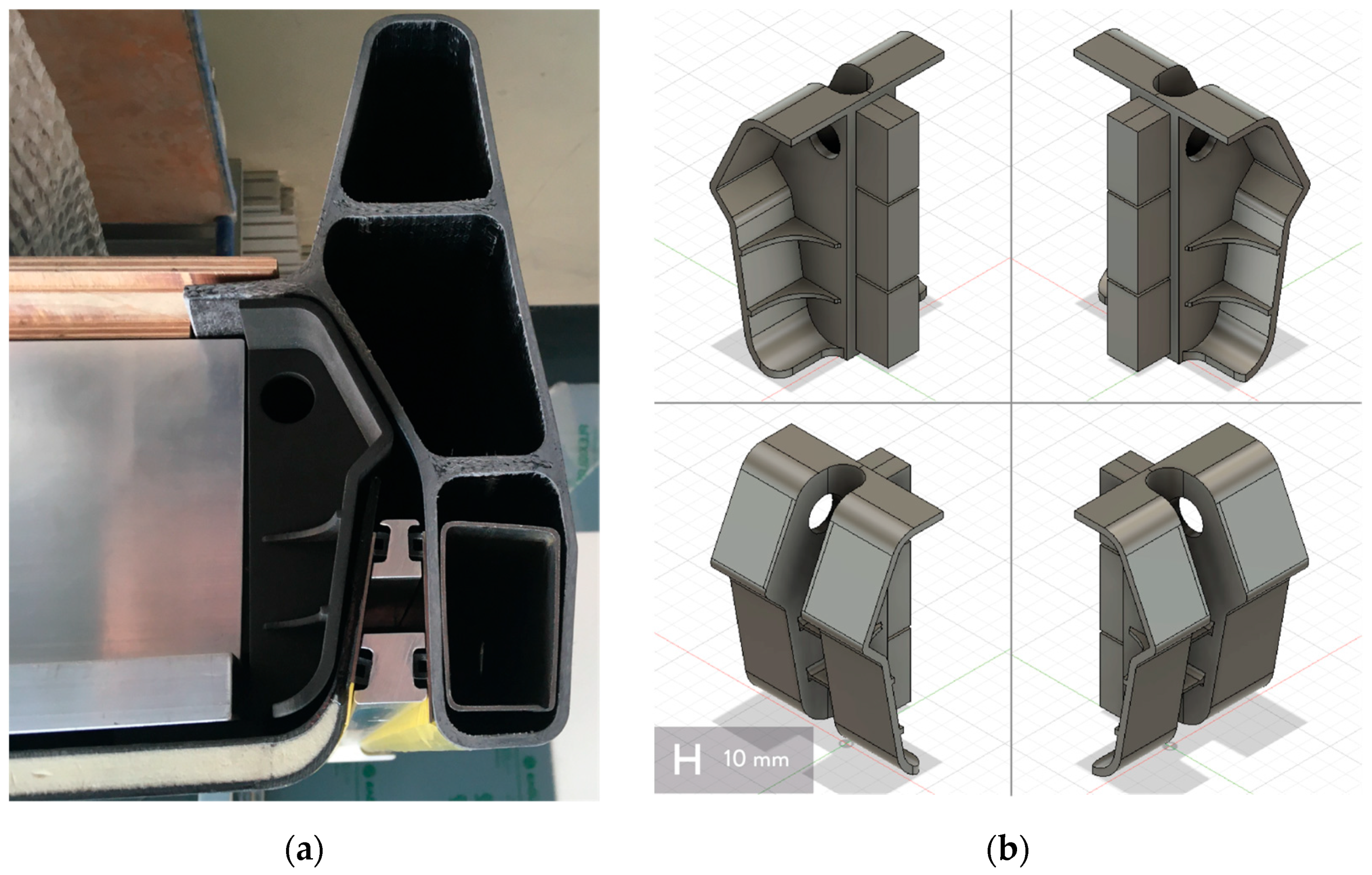

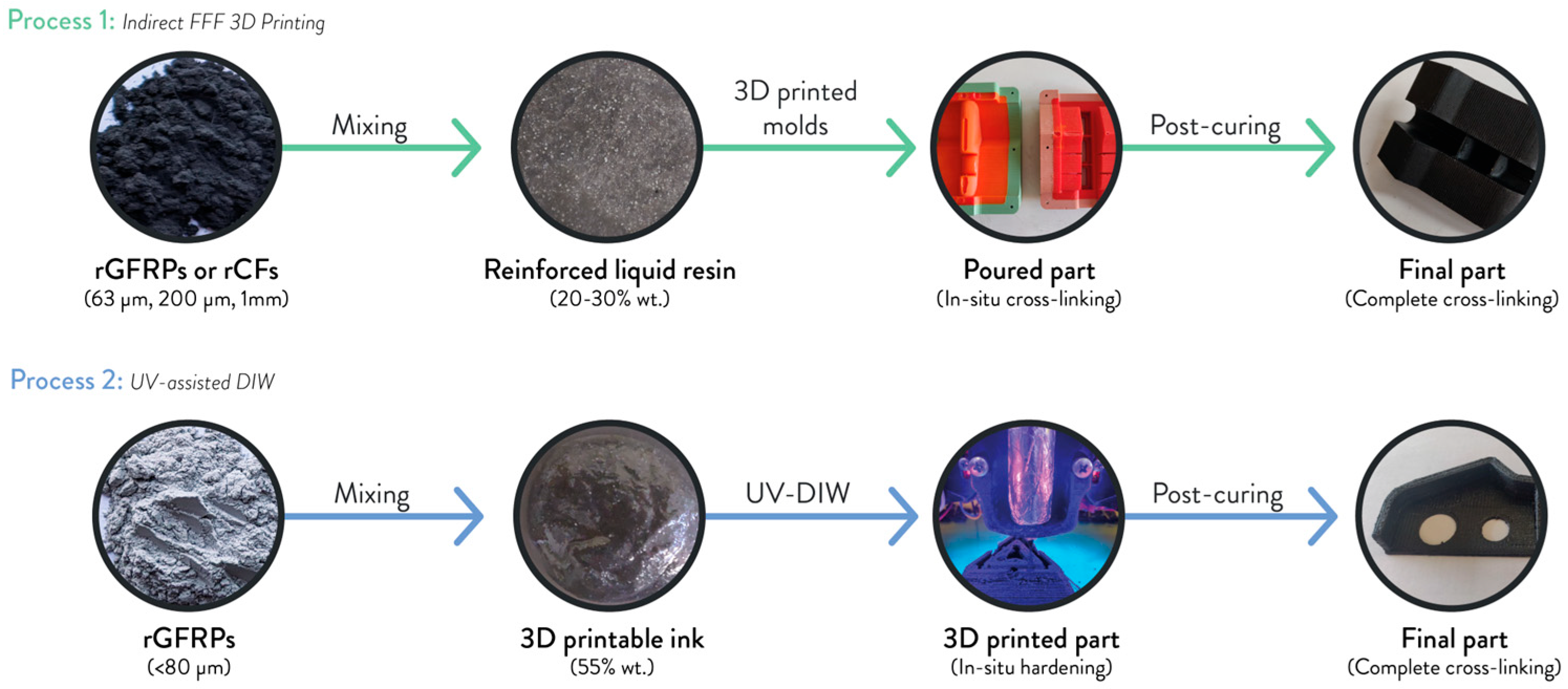
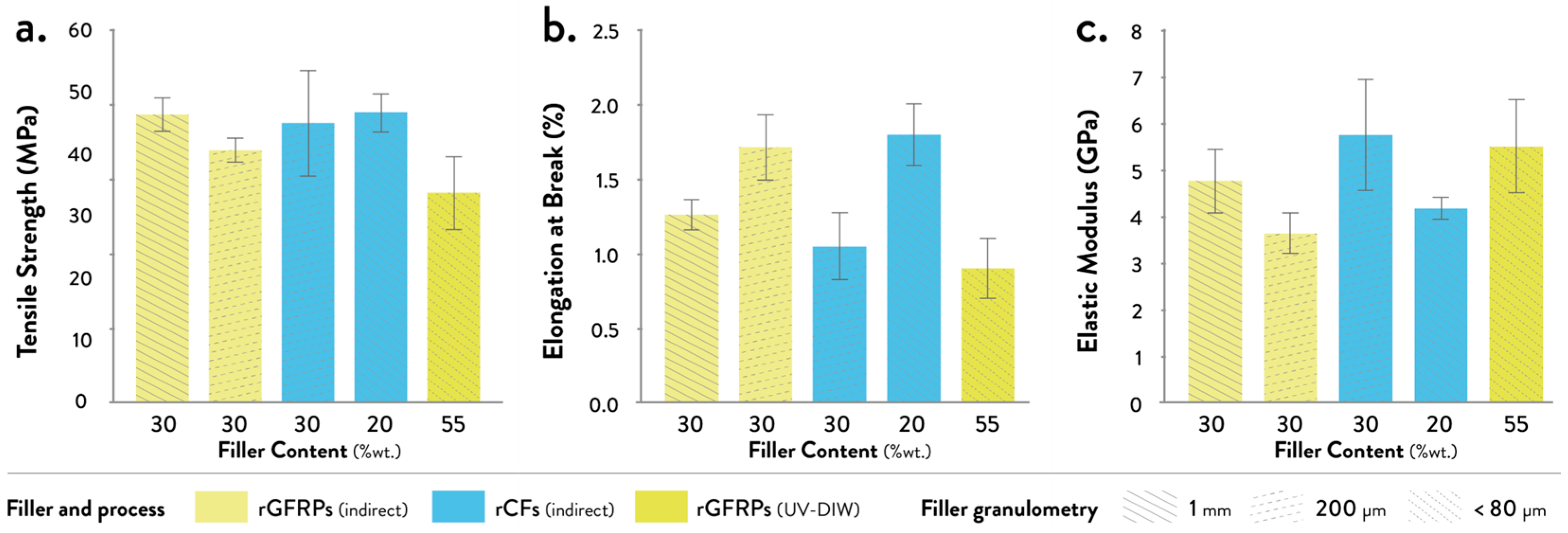
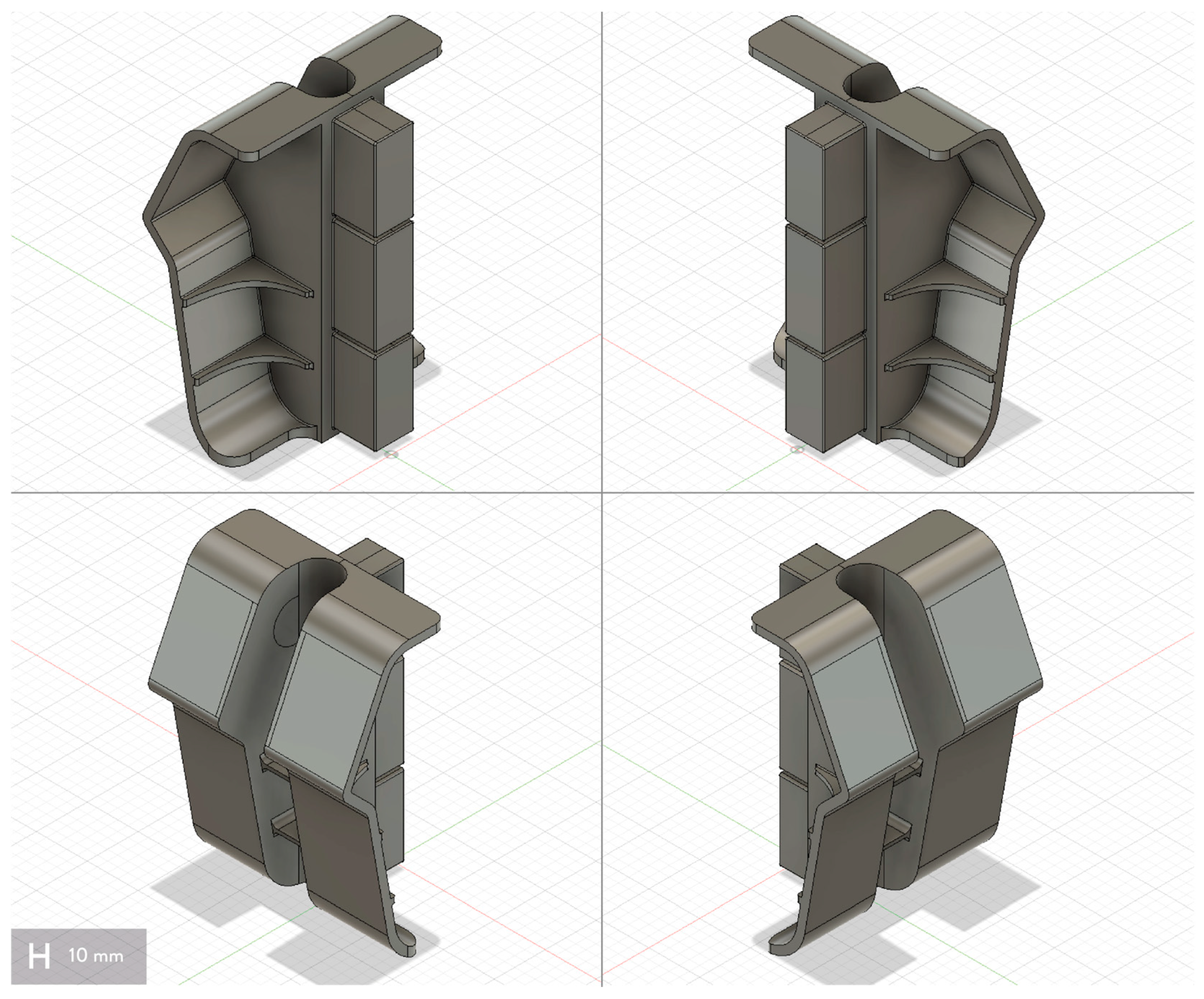
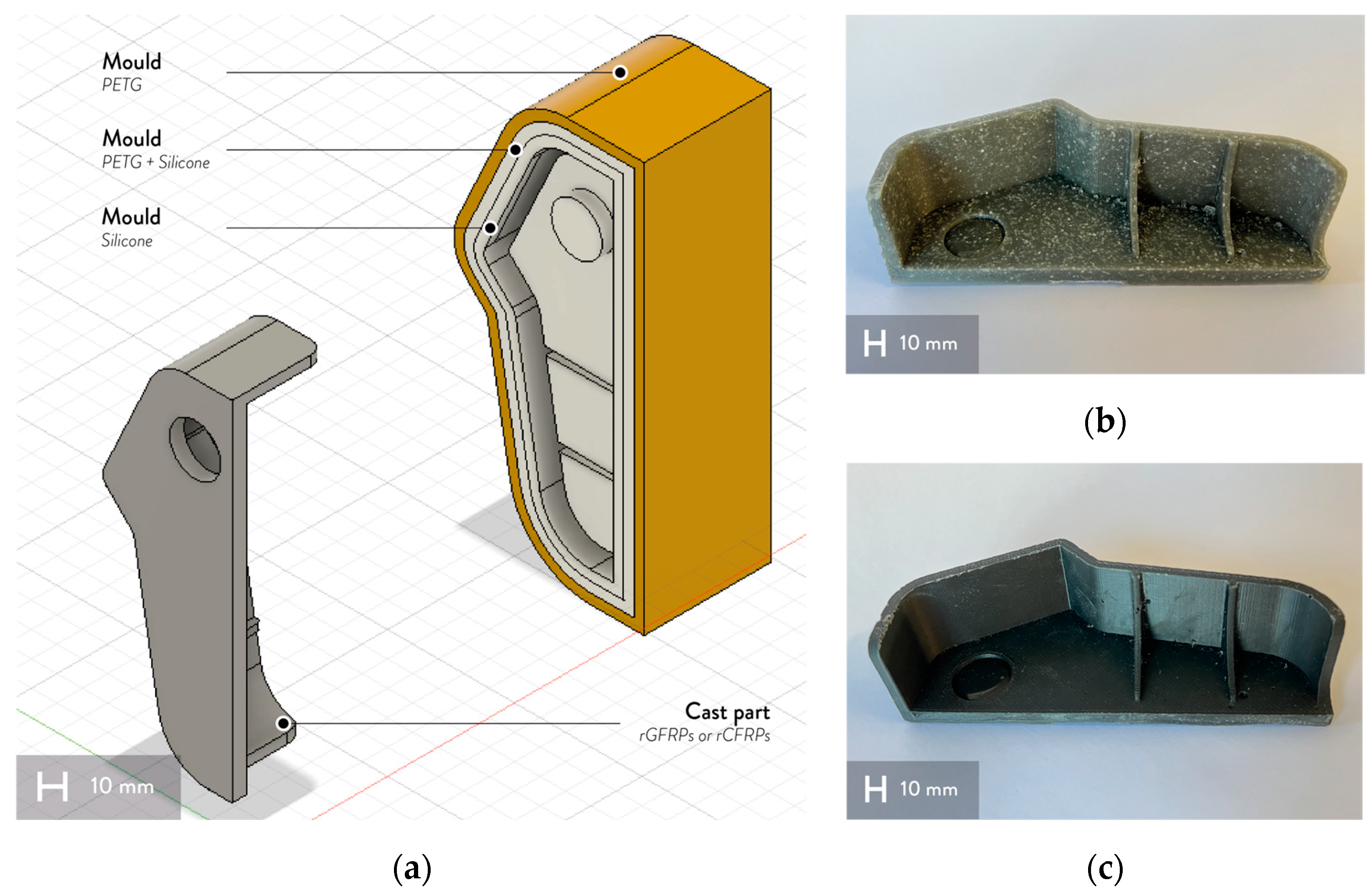
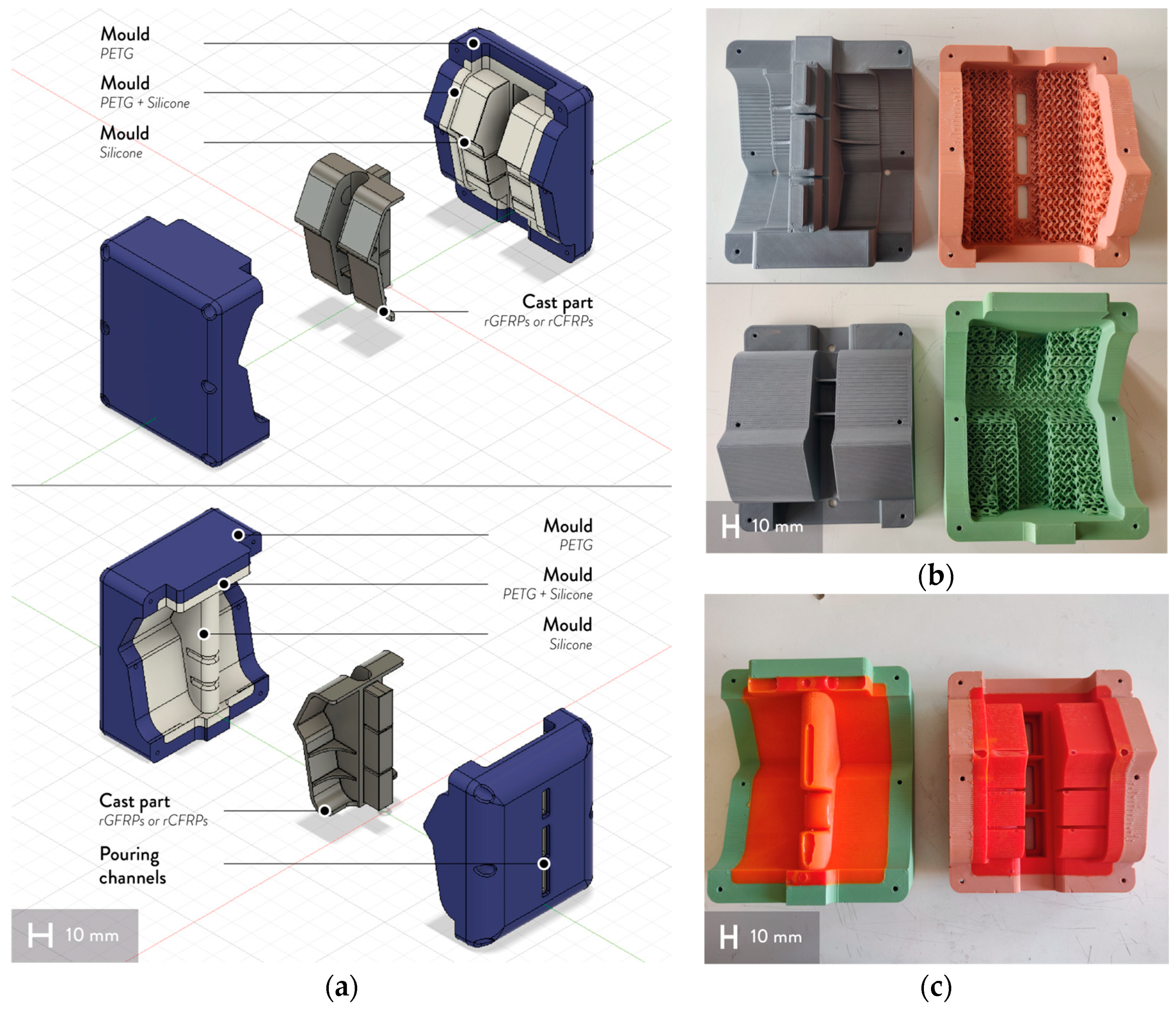
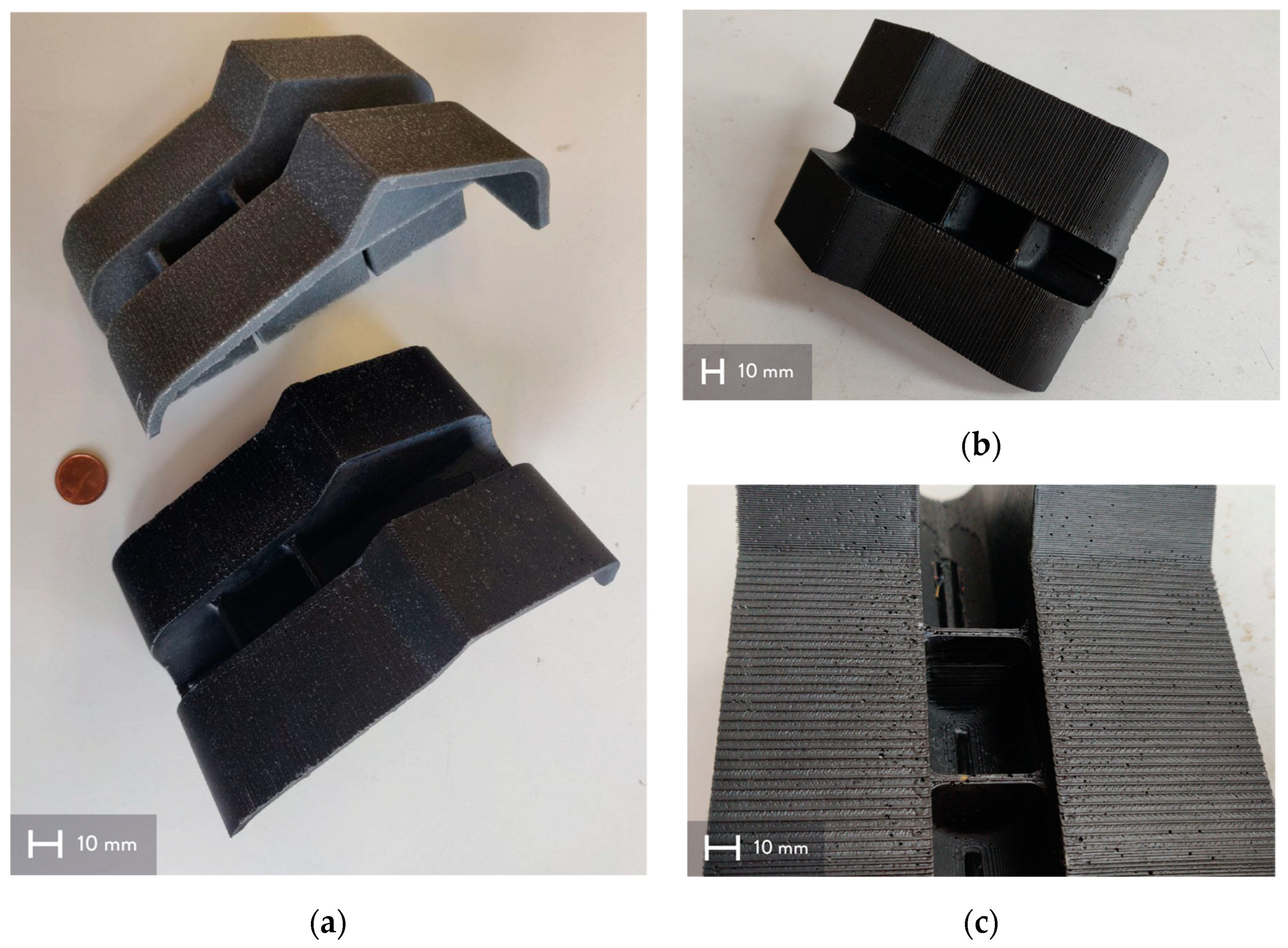
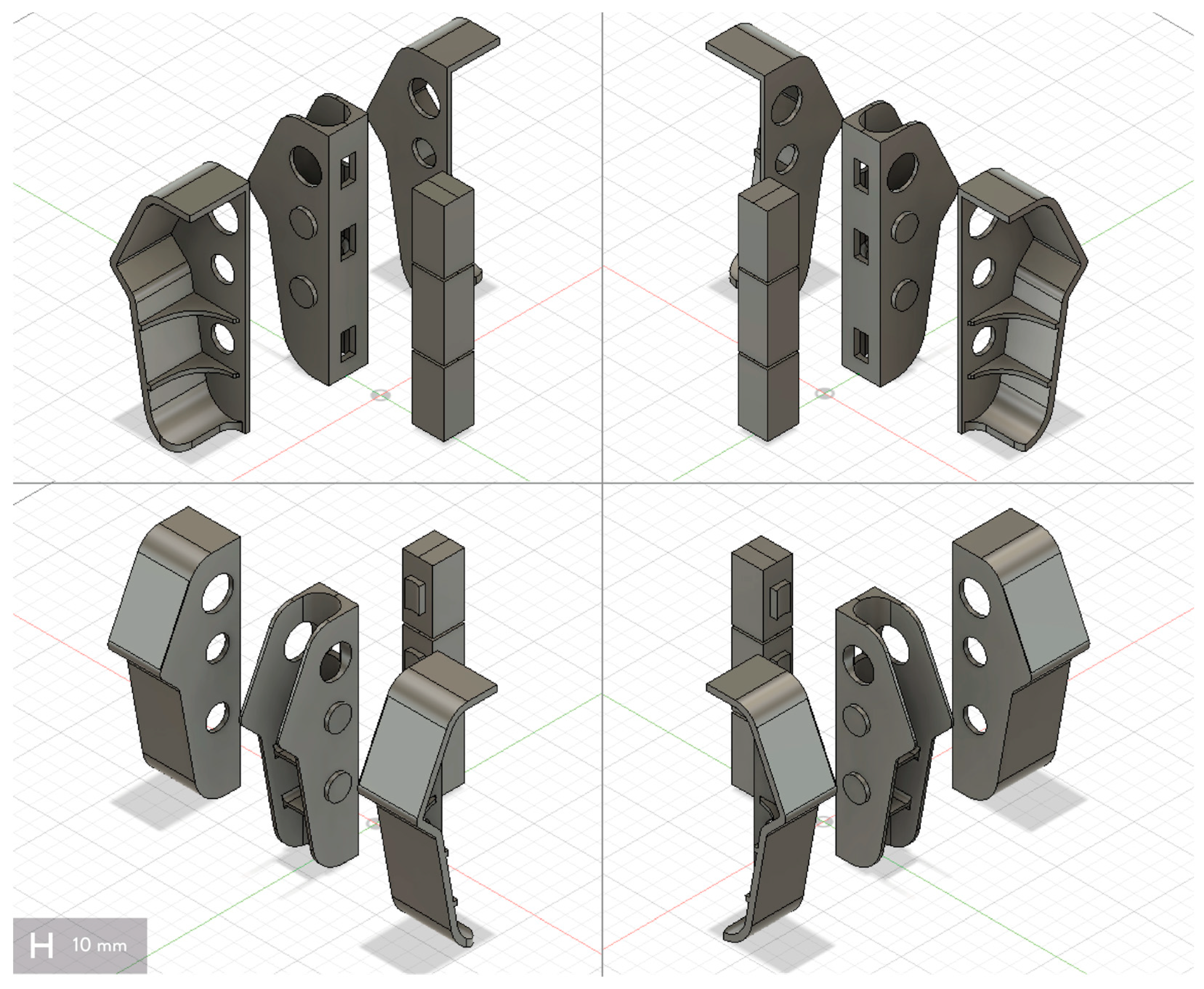

| Part | Parameters | Units | Values |
|---|---|---|---|
| Rigid molds (PETG) | Perimeters | // | 2 |
| Top/bottom layers | // | 4 | |
| Infill | % | 20 | |
| Infill (interlocking—bonding) | % | 40 | |
| Speed | mm/s | 45 | |
| Layer height | mm | 0.3 | |
| Nozzle diameter | mm | 0.6 | |
| Temperature (nozzle) | °C | 235 | |
| Temperature (bed) | °C | 85 | |
| Silicone counter molds (PLA) | Perimeters | // | 2 |
| Top/bottom layers | // | 3 | |
| Infill | % | 20 | |
| Speed | mm/s | 70 | |
| Layer height | mm | 0.3 | |
| Nozzle diameter | mm | 0.6 | |
| Temperature (nozzle) | °C | 215 | |
| Temperature (bed) | °C | 60 |
| Formulation | Parameters | Units | Values |
|---|---|---|---|
| 55% wt. GFRP recyclate (<80 μm) [20] | Perimeters | // | 2 |
| Top/bottom layers | // | 2 | |
| Infill | % | 100 | |
| Flow | % | 100 | |
| Speed | mm/s | 10–15 | |
| Layer height | mm | 0.25 | |
| Nozzle diameter | mm | 1 |
| AM Process | Formulation | Tensile Strength (MPa) | Elongation at Break (%) | Elastic Modulus (GPa) |
|---|---|---|---|---|
| Indirect FFF | 30% wt. rGFRPs (1 mm) | 46.3 ± 2.7 | 1.3 ± 0.1 | 4.8 ± 0.7 |
| Indirect FFF | 30% wt. rGFRPs (200 μm) | 40.5 ± 1.9 | 1.7 ± 0.2 | 3.6 ± 0.4 |
| Indirect FFF | 30% wt. rCFs (200 μm) | 44.8 ± 8.5 | 1.1 ± 0.2 | 5.8 ± 1.2 |
| Indirect FFF | 20% wt. rCFs (63 μm) | 46.6 ± 3.1 | 1.8 ± 0.2 | 4.2 ± 0.2 |
| UV-DIW | 55% wt. rGFRP (<80 μm) [20] | 33.6 ± 5.9 | 0.9 ± 0.2 | 5.5 ± 1.0 |
Disclaimer/Publisher’s Note: The statements, opinions and data contained in all publications are solely those of the individual author(s) and contributor(s) and not of MDPI and/or the editor(s). MDPI and/or the editor(s) disclaim responsibility for any injury to people or property resulting from any ideas, methods, instructions or products referred to in the content. |
© 2023 by the authors. Licensee MDPI, Basel, Switzerland. This article is an open access article distributed under the terms and conditions of the Creative Commons Attribution (CC BY) license (https://creativecommons.org/licenses/by/4.0/).
Share and Cite
Romani, A.; Caba, S.; Suriano, R.; Levi, M. Recycling Glass and Carbon Fibers for Reusable Components in the Automotive Sector through Additive Manufacturing. Appl. Sci. 2023, 13, 5848. https://doi.org/10.3390/app13105848
Romani A, Caba S, Suriano R, Levi M. Recycling Glass and Carbon Fibers for Reusable Components in the Automotive Sector through Additive Manufacturing. Applied Sciences. 2023; 13(10):5848. https://doi.org/10.3390/app13105848
Chicago/Turabian StyleRomani, Alessia, Stefan Caba, Raffaella Suriano, and Marinella Levi. 2023. "Recycling Glass and Carbon Fibers for Reusable Components in the Automotive Sector through Additive Manufacturing" Applied Sciences 13, no. 10: 5848. https://doi.org/10.3390/app13105848
APA StyleRomani, A., Caba, S., Suriano, R., & Levi, M. (2023). Recycling Glass and Carbon Fibers for Reusable Components in the Automotive Sector through Additive Manufacturing. Applied Sciences, 13(10), 5848. https://doi.org/10.3390/app13105848







